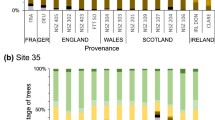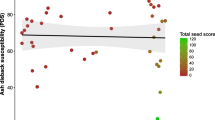Abstract
Context
It might be possible to establish a new generation of Fraxinus excelsior which is insusceptible towards ash dieback (agent: Hymenoscyphus pseudoalbidus) by efficient breeding. However, a considerable number of highly tolerant individuals which have the ability to pass on this trait to their progeny are needed.
Aims
The aim of this study was to identify the potential of provenances from southwestern Germany as a source of future selection for resistance or resistance breeding.
Methods
In July 2012 and 2013, ash dieback severity was scored by assessing the crown defoliation and the portion of epicormic shoots in the crowns in clonal seed orchards with a total of 1,726 ash trees in southwestern Germany.
Results
Ash dieback severity differed strongly between the orchards and the clones. Broad-sense heritability ranged from 0.18 to 0.55 for crown defoliation and from 0.48 to 0.58 for the portion of epicormic shoots between the orchards. Clones from nearby populations did not show differences in general levels of susceptibility.
Conclusion
The study highlights that there is high genetic variation in susceptibility and considerable genetic potential for resistance breeding in provenances from southwestern Germany.




Similar content being viewed by others
References
Bakys R, Vasiliauskas A, Ihrmark K, Stenlid J, Menkis A, Vasaitis R (2011) Root rot, associated fungi and their impact on health condition of declining Fraxinus excelsior stands in Lithuania. Scand J For Res 26:128–135
Delb H, Bublitz T, John R, Metzler B, Schumacher J (2013a) Waldschutzsituation 2012/2013 in Baden-Württemberg. AFZ-Der Wald 68:8–11
Delb H, Bublitz T, John R, Metzler B, Schumacher J (2013b) Waldschutzsituation 2012/2013 in Rheinland-Pfalz. AFZ-Der Wald 68:16–19
Douglas GC, Pliūra A, Dufour J, Mertens P, Jacques D, Fernandez-Manjares J, Buiteveld J, Parnuta G, Tudoroiu M, Curnel Y, Thomasset M, Jensen V, Knudsen M, Foffova E, Chandelier A, Steenackers M (2013) Common ash (Fraxinus excelsior L.). In: Pâques LE (ed) Forest tree breeding in Europe: current state-of-the-art and perspectives, Springer, pp 403–462
Enderle R, Peters F, Nakou K, Metzler B (2013) Temporal development of ash dieback symptoms and spatial distribution of collar rots in a provenance trial of Fraxinus excelsior. Eur J Forest Res 132:865–876. doi:10.1007/s10342-013-0717-y
Gross A, Holdenrieder O, Pautasso M, Queloz V, Sieber TN (2014) Hymenoscyphus pseudoalbidus, the causal agent of European ash dieback. Mol Plant Pathol 15:5–21
Hadfield JD (2010) MCMC methods for multi-response generalized linear mixed models: the MCMCglmm R Package. J Stat Softw 33:1–22
Houle D (1992) Comparing evolvability and variability of quantitative traits. Genetics 130:195–204
Husson C, Scala B, Cael O, Frey P, Feau N, Ioos R, Marcais B (2011) Chalara fraxinea is an invasive pathogen in France. Eur J Plant Pathol 130:311–324
Husson C, Caël O, Grandjean JP, Nageleisen LM, Marçais B (2012) Occurrence of Hymenoscyphus pseudoalbidus on infected ash logs. Plant Pathol 61:889–895. doi:10.1111/j.1365-3059.2011.02578.x
Kirisits T, Freinschlag C (2012) Ash dieback caused by Hymenoscyphus pseudoalbidus in a seed plantation of Fraxinus excelsior in Austria. J Agric Ext Rural Dev 4:184–191. doi:10.5897/JAERD12.046
Kjær ED, Wellendorf H (1997) Variation in flowering and reproductive success in a Danish Picea abies (Karst.) seed orchard. Int J For Genet 4:181–188
Kjær ED, McKinney LV, Nielsen LR, Hansen LN, Hansen JK (2012) Adaptive potential of ash (Fraxinus excelsior) populations against the novel emerging pathogen Hymenoscyphus pseudoalbidus. Evol Appl 5:219–228. doi:10.1111/j.1752-4571.2011.00222.x
Kowalski T (2006) Chalara fraxinea sp. nov. associated with dieback of ash (Fraxinus excelsior) in Poland. For Pathol 36:264–270. doi:10.1111/j.1439-0329.2006.00453.x
Kowalski T, Holdenrieder O (2009) Pathogenicity of Chalara fraxinea. For Pathol 39:1–7. doi:10.1111/j.1439-0329.2008.00565.x
Lenz H, Straßer L, Baumann M, Baier U (2012) Boniturschlüssel zur Einstufung der Vitalität von Alteschen. AFZ-Der Wald 67:18–19
Lindgren D, Mullin TJ (1998) Relatedness and status number in seed orchard crops. Can J For Res 28:276–283
Lygis V, Vasiliauskas R, Stenlid J (2005) Wood-inhabiting fungi in stems of Fraxinus excelsior in declining ash stands of northern Lithuania, with particular reference to Armillaria cepistipes. Scand J For Res 20:337–346
McKinney LV, Nielsen LR, Hansen JK, Kjær ED (2011) Presence of natural genetic resistance in Fraxinus excelsior (Oleaceae) to Chalara fraxinea (Ascomycota): an emerging infectious disease. Heredity 106:788–797. doi:10.1038/hdy.2010.119
McKinney LV, Thomsen IM, Kjær ED, Bengtsson SBK, Nielsen LR (2012) Rapid invasion by an aggressive pathogenic fungus (Hymenoscyphus pseudoalbidus) replaces a native decomposer (Hymenoscyphus albidus): a case of local cryptic extinction? Fungal Ecol 5:663–669
McKinney LV, Nielsen LR, Collinge DB, Thomsen IM, Hansen JK, Kjær ED (2014) The ash dieback crisis: genetic variation in resistance can prove a long term solution. Plant Pathol. doi:10.1111/ppa.12196
Metzler B, Enderle R, Karopka M, Töpfner K, Aldinger E (2012) Entwicklung des Eschentriebsterbens in einem Herkunftsversuch an verschiedenen Standorten in Süddeutschland. German J For Res (AFJZ) 183:168–180
Metzler B, Baumann M, Baier U, Heydeck P, Bressem U, Lenz H (2013) Bundesweite Zusammenstellung: Handlungsempfehlungen beim Eschentriebsterben. AFZ-Der Wald 68:17–20
Orlikowski LB, Ptaszek M, Rodziewicz A, Nechwatal J, Thinggaard K, Jung T (2011) Phytophthora root and collar rot of mature Fraxinus excelsior in forest stands in Poland and Denmark. For Pathol 41:510–519
Pautasso M, Aas G, Queloz V, Holdenrieder O (2013) European ash (Fraxinus excelsior) dieback—a conservation biology challenge. Biol Conserv 158:37–49
Pliūra A, Lygis V, Suchockas V, Bartkevičius E (2011) Performance of twenty four European Fraxinus excelsior populations in three Lithuanian progeny trials with a special emphasis on resistance to Chalara fraxinea. Balt For 17:17–34
Poland TM, McCullough DG (2006) Emerald ash borer: invasion of the urban forest and the threat to North America’s ash resource. J For 104:118–124
Queloz V, Grünig CR, Berndt R, Kowalski T, Sieber TN, Holdenrieder O (2011) Cryptic speciation in Hymenoscyphus albidus. For Pathol 41:333–342. doi:10.1111/j.1439-0329.2010.00645.x
Roloff A, Pietzarka U (1997) Fraxinus excelsior Linné 1753. In: Schütt et al. (eds) Enzyklopädie der Holzgewächse, 7th edn, ecomed, Landsberg am Lech, pp 1–15
Schröter H, Delb H, John R, Metzler B (2010a) Waldschutzsituation 2009/2010 in Baden-Württemberg. AFZ-Der Wald 65:8–11
Schröter H, Delb H, Metzler B (2010b) Waldschutzsituation 2009/2010 in Rheinland-Pfalz. AFZ-Der Wald 65:16–17
Skovsgaard JP, Thomsen IM, Skovgaard IM, Martinussen T (2010) Associations between symptoms of dieback in even-aged stands of ash (Fraxinus excelsior L.). For Pathol 40:7–18
Stener LG (2013) Clonal differences in susceptibility to the dieback of Fraxinus excelsior. Scand J For Res 28:1–12. doi:10.1080/02827581.2012.735699
Straw NA, Williams DT, Kulinich O, Gninenko YI (2013) Distribution, impact and rate of spread of emerald ash borer Agrilus planipennis (Coleoptera: Buprestidae) in the Moscow region of Russia. Forestry 86:515–522. doi:10.1093/forestry/cpt031
Visscher PM, Hill WG, Wray NR (2008) Heritability in the genomics era—concepts and misconceptions. Nat Rev Genet 9:255–266. doi:10.1038/nrg2322
Zhao YJ, Hosoya T, Baral HO, Hosaka K, Kakishima M (2012) Hymenoscyphus pseudoalbidus, the correct name for Lambertella albida reported from Japan. Mycotaxon 122:25–41
Acknowledgments
Our thanks go to the Research Institute for Forest Ecology and Forestry of Rheinland-Pfalz for the kind support during the assessments and for providing their seed orchards. For their help during the surveys, we thank Johanna Bußkamp, Jonas Wehrle, Ricardo Rivero, Robert Krämer, Martina Stabel, Dietmar Weber and particularly Hermann Schott, who had good ideas for the development of the disease severity scoring system. We are grateful to Dr. Franziska Peters for revising the English and to anonymous reviewers for valuable suggestions improving the manuscript.
Funding
The study was funded by the Forest Research Institute of Baden-Wuerttemberg.
Author information
Authors and Affiliations
Corresponding author
Additional information
Handling Editor: Cécile Robin
Contribution of the co-authors
Rasmus Enderle: conception of the study, responsible for the data collection, data analyses except modelling and writing the manuscript.
Aikaterini Nakou: constructing and fitting the model.
Kristina Thomas: supervising the seed orchards of Rheinland-Pfalz and contributing to the data collection.
Berthold Metzler: supervising the study and contributing to the data collection.
Appendix 1
Appendix 1
Rights and permissions
About this article
Cite this article
Enderle, R., Nakou, A., Thomas, K. et al. Susceptibility of autochthonous German Fraxinus excelsior clones to Hymenoscyphus pseudoalbidus is genetically determined. Annals of Forest Science 72, 183–193 (2015). https://doi.org/10.1007/s13595-014-0413-1
Received:
Accepted:
Published:
Issue Date:
DOI: https://doi.org/10.1007/s13595-014-0413-1




